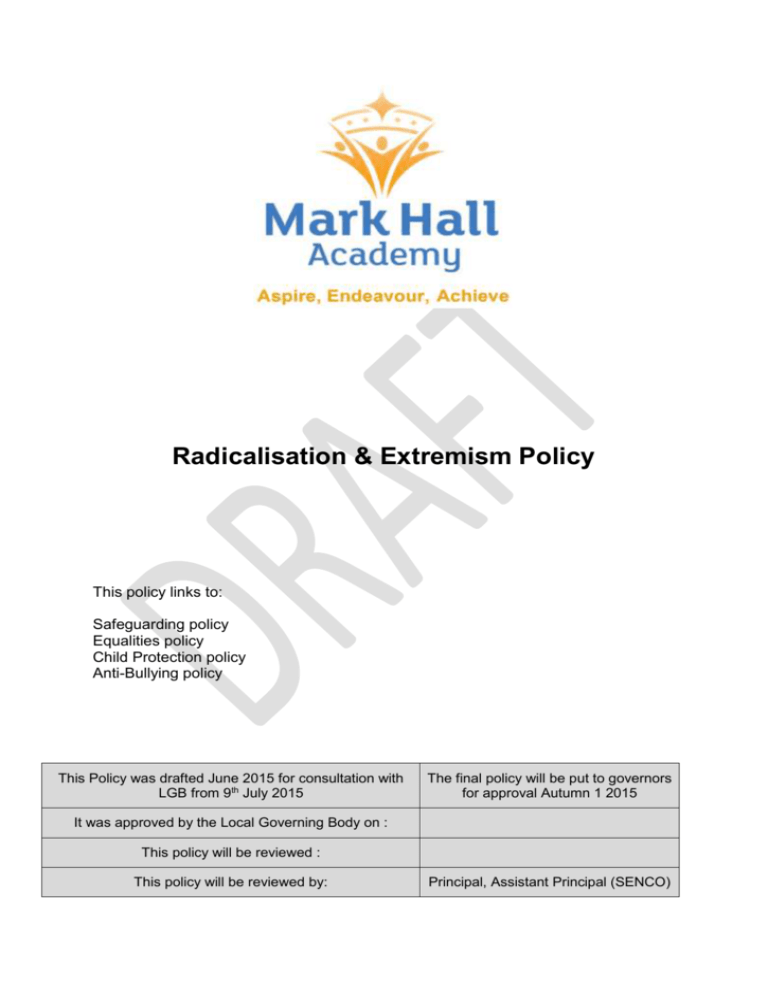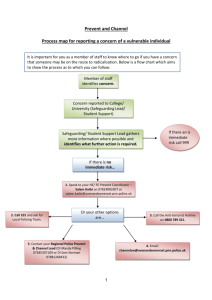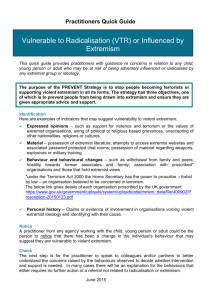Draft-MHA-Radicalisation-and-Extremism-Policy-1
advertisement

Radicalisation & Extremism Policy This policy links to: Safeguarding policy Equalities policy Child Protection policy Anti-Bullying policy This Policy was drafted June 2015 for consultation with LGB from 9th July 2015 The final policy will be put to governors for approval Autumn 1 2015 It was approved by the Local Governing Body on : This policy will be reviewed : This policy will be reviewed by: Principal, Assistant Principal (SENCO) & CP/Safeguarding Lead Radicalisation and Extremism Policy Rationale In today’s modern world, children may be exposed to many radical and extremist views, both through the people they may meet and through a wide range of media. Policy and Procedure Students at Mark Hall Academy are privy to a range of avenues where radicalisation and extremism is discussed. Students have ALT assemblies on the topic and learn about what radicalisation and extremism are, with examples in the world. They are also taught about having their own voice and not always heeding the views of other people, especially if they have doubts about them. The PSHCEE curriculum covers aspects of radicalisation and extremism too, as well as the close links to bullying and rights. Ethical and moral issues are taught across all Key Stages and students learn about the right and wrongs in society. The academy has an internal referral process whereby staff can flag up any concerns they have around radicalisation and extremism. Any colleague with concerns should complete the R and E Concern Form and forward immediately to Emma Ruffles (Assistant Principal and CPO Deputy) and Sue Collins (CPO Lead) The concern is logged and a timeline started. The Police and Social Services will be contacted. The academy has a risk assessment in place and also identifies students who may be at risk of R and E. Please see Radicalisation and Extremism Concern Form and Risk Assessment attached at Appendix I and Appendix II The academy works closely with the Police and their Prevent Agenda (please see Appendix III and Appendix IV) Appendix I Radicalisation and Extremism Concern Form Student Name: Staff logging concern: Date: Inappropriate content on phone Overheard conversation Gang mentality Inappropriate material held by pupil Propaganda material Other: Nature of concern (please tick) Describe in a much detail as possible your concern and note any behaviours observed: Once complete please email this form IMMEDIATELY to Emma Ruffles – Assistant Principal at e.ruffles@mha.attrust.org.uk and Sue Collins at s.collins@mha.attrust.org.uk Appendix I CPO Lead Follow up Actions taken: Referral to Social Care Name of contact : Phone call to Police Name of contact : Discussed with Principal Date and time : Phone call to parents after the above have taken place Timeline started and risk assessment undertaken CPO to describe the outcome of the above process and the next steps to safeguard the child Signed : Date: Appendix II Radicalisation and Extremism Risk Assessment The Academy Does the academy have a policy? Draft in development Does the academy work with outside agencies on R and E? YES Has the academy got a nominated R and E Lead? Do staff have a process to voice their concerns? YES Do students have a process to voice their concerns? YES Home Group Tutor, Phase Leader, Guidance, Prefects, Student Parliament, Culture & Ethos Voice Are there opportunities for students to learn about R and E? Are there documented cases of R and E at the academy? Further development needed NO PSHCEE & Assemblies – further development Is the academy particularly prone to R and E? NO Cohort of students are white British majority Evaluation LOW RISK Policy needed and to be reviewed by Governing Body every new academic year. Assemblies and curriculum are sufficient to provide students knowledge of R and E and what to look for. Are students aware of what R and E is? In part assemblies need to be given by ALT on topic and delivered by carefully chosen trained team through PSHEE Are individual students risk assessed? YES (once policy is fully adopted) If an R and E Concern form is filled in. Students who are perceived to be vulnerable are identified early and flagged up to all staff Students at risk? NONE - June 2015 LOW RISK YES ALT June 2015 Staff consultation June/July 2015 LGB 9th July Police & Social Care Emma Ruffles – Assistant Principal & Sue Collins CPO Lead Internal Referral Form The Pupils Evaluation staff to continue to monitor BME cohort and continue to educate via appropriate curriculum content. The Community The local community which the academy serves consists predominantly of white British families. There is an increasing diversity in Harlow and we will need to be proactive in engaging all cultures and faiths. LOW RISK Evaluation The academy will work with parents on R and E through the Parent Council and engage with community/faith groups Appendix III PREVENT SELF ASSESSMENT – Mark Hall Academy PREVENT OBJECTIVE 1: Clear leadership and accountable structures are in place and visible throughout the organisation PREVENT OBJECTIVE 2: Staff and the Governing Body have been appropriately trained according to their role PREVENT OBJECTIVE 3: An appropriate reporting and referral process is in place and referrals are being managed effectively PREVENT OBJECTIVE 4: A broad and balanced curriculum that helps protect students against extremism and promotes community cohesion Mark Hall Academy Name of assessor(s): Corinne Franceschi (Principal); Emma Ruffles (Assistant Principal Date of assessment: June 2015 To be reviewed: Termly and update reports to LGB 1. Clear leadership and accountable structures are in place and visible throughout the organisation Evidence Tick as appropriate Self Assessed Rating (RAG) There is an identified strategic PREVENT lead within the academy √ - Emma Ruffles & Sue Collins G The strategic lead understands the expectations and key priorities to deliver PREVENT and that this is embedded within Safeguarding Procedures √ G The Academy Leadership Team are aware of the PREVENT Strategy and its objectives √ G There is a clear awareness of roles and responsibilities throughout organisation regarding PREVENT √ - Staff the need to flag up concerns and there is a clear process to follow now but follow training on new A policy and protocols needed PREVENT safeguarding responsibilities are explicit within the academy’s Safeguarding Team √ - R and E is connected to Safeguarding and Child Protection Policies and systems in the academy A/G The Prevent agenda and its objectives has been embedded within the appropriate Safeguarding processes Within MHA CP policy and staff have had training. Needs to be re-visited. A 2. Staff and the Governing Body have been appropriately trained according to their role Evidence Tick as appropriate Self Assessed Rating (RAG) A plan is in place to include Workshop to Raise Awareness of Prevent (WRAP) training so that key staff and Governors understand the risk of radicalisation and extremism and know how to recognise and refer children who may be vulnerable √ Details of WRAP courses including frequency and availability are cascaded to all relevant staff √ A/R Plan in place; key staff aware and LGB have had CP/Safeguarding training. They need more specific training on R&E/PREVENT G Further training on the Prevent agenda is made available to the Strategic Prevent lead and Safeguarding leads where appropriate √ G There is appropriate staff guidance and literature available to staff on the Prevent agenda √ A 3. An appropriate reporting and referral process is in place and referrals are being managed effectively Evidence Tick as appropriate Self Assessed Rating (RAG) Ensure that preventing young people from being exposed to radicalisation or extremism is part of the academy’s safeguarding policies and procedures √ - CP and Safeguarding policies, draft R&E policy in process with referral form A A single point of contact [SPoC] for any PREVENT concerns raised by staff within the academy has been identified √ - referral form and staff leads – Emma Ruffles & Sue Collins An appropriate internal PREVENT referral process has been developed √ - referral form and clear process of next steps in draft policy A Staff need to be introduced to R&E policy A Draft Policy and process to be shared and then adopted Partner agency communication channels have been developed PREVENT Lead for Harlow/Essex??? An audit trail for notification reports/referrals exists √ - timelines that fall under the Child protection Process have to be created once a referral is made PREVENT referrals/notifications are being managed or overseen by relevant staff √ - will be by Emma Ruffles & Sue Collins A process is in place to identify and develop ‘lessons learnt’ √ - will be through regular meetings between academy and local Harlow/Essex PREVENT Leads R Links need to be established A A Within draft policy; to be adopted A/R within draft policy; channels/meetings to be set up 4. A broad and balanced curriculum that helps protect students against extremism and promotes community cohesion Evidence Tick as appropriate Self Assessed Rating (RAG) The academy has a range of initiatives and activities that promote the spiritual, moral, social and emotional needs of children aimed at protecting them from radicalisation and extremist influences √ - PSHCEE, assemblies, across the curriculum, Student Parliament, Voice groups, workshops, drop down days A Further developments needed focussed specifically on R&E The academy delivers training that helps develop critical thinking skills around the power of influence, particularly on-line and through social media. In part… A Students are aware of the benefits of community cohesion and the damaging effects of extremism on community relations √ - students have shared ‘value’ words to be used within school and the community. Weekly assemblies are run on these value words by PLs & ALT. A/G Staff are able to provide appropriate challenge to students, parents or governors if opinions are expressed that are contrary to fundamental British values and promotion of community cohesion √ - referral System to be put in place through this policy that follows child protection process. A Appendix iv PREVENT Safeguarding Objectives Within this overall framework the Prevent strategy will specifically: • respond to the ideological challenge of terrorism and the threat we face from those who promote it; • prevent people from being drawn into terrorism and ensure that they are given appropriate advice and support; and • work with sectors and institutions where there are risks of radicalisation which we need to address. Schools can help to protect children from extremist and violent views in the same ways that they help to safeguard children from drugs, gang violence or alcohol. The purpose must be to protect children from harm and to ensure that they are taught in a way that is consistent with the law and our values. Awareness of Prevent and the risks it is intended to address are both vital. Staff can help to identify, and to refer to the relevant agencies, children whose behaviour suggests that they are being drawn into terrorism or extremism. Schools of all kinds can play a role in enabling young people to explore issues like terrorism and the wider use of violence in a considered and informed way. Schools can facilitate understanding of wider issues within the context of learning about the values on which our society is founded and our system of democratic government. These are important for reasons which go far beyond Prevent but they connect to the Prevent agenda. PREVENT referrals should be reported in line with other safeguarding procedures. You can contact the Essex Police to discuss any concerns on: PREVENT@essex.pnn.police.uk Appendix v Channel: Vulnerability Assessment Framework The vulnerability assessment framework is used by Channel projects to guide decisions about whether an individual needs support to address their vulnerability to radicalisation and the kind of support that they need. It should be read alongside the Channel guidance (http://www.homeoffice.gov.uk/publications/counter-terrorism/prevent/channel-guidance). Channel is a key element of the Prevent strategy (http://www.homeoffice.gov.uk/publications/counter-terrorism/prevent/prevent-strategy/). It is a multi-agency approach to protect people at risk from radicalisation. Channel is about safeguarding children and adults from being drawn into committing terrorist-related activity. It is about early intervention to protect and divert people away from the risk they face before illegality occurs. It should not be assumed that the characteristics set out below necessarily indicate that a person is either committed to terrorism or may become a terrorist. The assessment framework involves three dimensions: engagement, intent and capability, which are considered separately. 1. Engagement with a group, cause or ideology Engagement factors are sometimes referred to as “psychological hooks”. They include needs, susceptibilities, motivations and contextual influences and together map the individual pathway into terrorism. They can include: • Feelings of grievance and injustice • Feeling under threat • A need for identity, meaning and belonging • A desire for status • A desire for excitement and adventure • A need to dominate and control others • Susceptibility to indoctrination • A desire for political or moral change • Opportunistic involvement • Family or friends involvement in extremism • Being at a transitional time of life • Being influenced or controlled by a group • Relevant mental health issues 2. Intent to cause harm Not all those who become engaged by a group, cause or ideology go on to develop an intention to cause harm, so this dimension is considered separately. Intent factors describe the mindset that is associated with a readiness to use violence and address what the individual would do and to what end. They can include: • Over-identification with a group or ideology • ‘Them and Us’ thinking • Dehumanisation of the enemy • Attitudes that justify offending • Harmful means to an end • Harmful objectives 3. Capability to cause harm Not all those who have a wish to cause harm on behalf of a group, cause or ideology are capable of doing so, and plots to cause widespread damage take a high level of personal capability, resources and networking to be successful. What the individual is capable of is therefore a key consideration when assessing risk of harm to the public. Factors can include: • Individual knowledge, skills and competencies • Access to networks, funding or equipment • Criminal Capability






